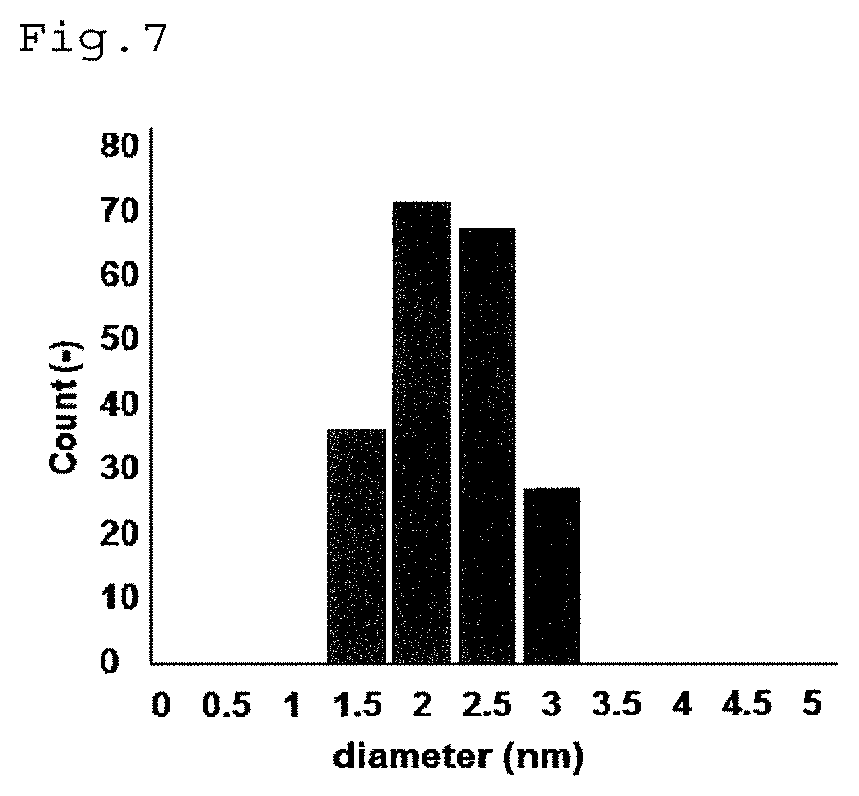Hydrogenation reaction catalyst used to hydrogenate amide compound and method for producing amine compound using same
a hydrogenation reaction and hydrogenation reaction technology, applied in the field of hydrogenation reaction catalyst used to hydrogenate amide compound and method for producing amine compound using same, can solve the problems of complex post-treatment operation, poor substrate applicability, and difficult reaction for converting amide compound into amine compound, etc., to achieve easy recovery, easy synthesis of amine compound, and low cost and safety
- Summary
- Abstract
- Description
- Claims
- Application Information
AI Technical Summary
Benefits of technology
Problems solved by technology
Method used
Image
Examples
production example 1
[0062]Preparation of Pt—V / HAP:
[0063]To 90 mL of acetone, 0.4 mmol of Pt(acac)2 manufactured by N.E. CHEMCAT Corporation, and 0.4 mmol of VO(acac)2 of Sigma-Aldrich Co. LLC were added, followed by stirring at room temperature for 30 minutes. Further, 1.0 g of HAP (trade name “tricalcium phosphate”) of Wako Pure Chemical Industries, Ltd. was added thereto, followed by stirring at room temperature for 4 hours. The solvent was removed from the obtained mixture using a rotary evaporator, whereby a light green powder was obtained. The obtained powder was dried overnight at 110° C. Further, the dried powder was ground with an agate mortar and then fired in the atmosphere at 300° C. for 2 hours, whereby a dark gray powder (Pt—V / HAP) was obtained.
[0064]For Pt—V / HAP obtained above, various analyses were performed. A TEM image of Pt—V / HAP is shown in FIG. 1, an ADF STEM image is shown in FIG. 2, an elemental mapping image of Ca is shown in FIG. 3, an elemental mapping image of V is shown in FI...
production example 2
[0065]Preparation of Pt—V / C:
[0066]Pt—V / C was obtained in the same manner except that HAP in Production Example 1 was changed to porous carbon (trade name: Carbon Mesoporous) of Sigma-Aldrich Co. LLC. It was found that the molar ratio [Pt:V] is 6:7 in terms of the number of moles of platinum (Pt) as metal:vanadium (V) as metal, and the amount of platinum as metal is 5.8 wt %.
production example 3
[0067]Preparation of Pt—V / TiO2:
[0068]Pt—V / TiO2 was obtained in the same manner except that HAP in Production Example 1 was changed to titania (JRC-TIO-4) that is a reference catalyst of the Catalyst Society of Japan. It was found that the molar ratio [Pt:V] is 6:7 in terms of the number of moles of platinum (Pt) as metal:vanadium (V) as metal, and the amount of platinum as metal is 5.8 wt %.
PUM
| Property | Measurement | Unit |
|---|---|---|
| pressure | aaaaa | aaaaa |
| temperature | aaaaa | aaaaa |
| pressure | aaaaa | aaaaa |
Abstract
Description
Claims
Application Information
 Login to View More
Login to View More - R&D
- Intellectual Property
- Life Sciences
- Materials
- Tech Scout
- Unparalleled Data Quality
- Higher Quality Content
- 60% Fewer Hallucinations
Browse by: Latest US Patents, China's latest patents, Technical Efficacy Thesaurus, Application Domain, Technology Topic, Popular Technical Reports.
© 2025 PatSnap. All rights reserved.Legal|Privacy policy|Modern Slavery Act Transparency Statement|Sitemap|About US| Contact US: help@patsnap.com



